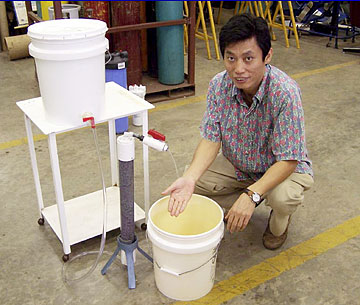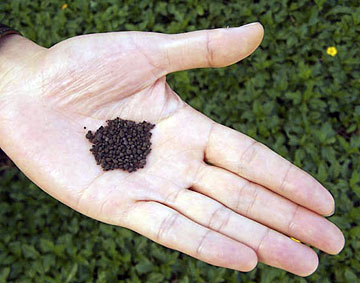New technology filters arsenic
A University of Hawaii researcher says that MicroNose could help clean the Ala Wai
By Helen Altonn
haltonn@starbulletin.com
A University of Hawaii-Manoa researcher has developed technology to remove arsenic from drinking water -- a critical problem in many states and countries.
Hawaii's ground water has no arsenic, a highly poisonous chemical element found in rocks, soil and water and used in compounds to make insecticides, medicines, glass and other items, said Liangjie Dong.
But his technology, called MicroNose, could be used to clean out metals under normal conditions in the Ala Wai Canal, said the molecular biosciences and bioengineering doctoral student in the College of Tropical Agriculture and Human Resources.
He proposed a project to the state Department of Health before the current flow of sewage into the canal to change it to "a clean river," he said.
He said he's also had calls from the Big Island about using his technology to remove zinc and nickel from waters there. Those metals are a problem, but not as harmful as arsenic, he said.

COURTESY PHOTO
University of Hawaii-Manoa researcher Liangjie Dong, left, has developed technology to remove arsenic from drinking water. MicroNose is a mixture of clay, iron and other common ingredients that produce absorbent and permeable pottery granules, shown below.
|
|
Dong discovered MicroNose, a mixture of clay, iron and other common ingredients that produce absorbent and permeable pottery granules, after experimenting about a year with 32 other approaches.
The granules function like the mucous membrane in the human nose, he explained. Each granule contains thousands of tiny holes "and acts like a filter, just as our nose can trap large unwanted particles like dirt or pollen," he said.
Initial results showed his technology was 99.9 percent effective in removing arsenic from drinking water, he said. Also, it costs about 60 percent less than the usual filter products, it preserves good water qualities, and doesn't use materials causing environmental concerns, he said.
His invention has removed lead, cadmium, chromium, cobalt, nickel, copper, zinc and manganese from ground water, Dong said, adding that it has "a great potential for purifying industrial wastewater as well."
James Cowen, UH oceanographer and member of Dong's research team, said MicroNose "is very, very promising technology for removal of arsenic from groundwater or other drinking water, with potential to be very economical, even for the most developing of nations and communities.
"There are no downsides we've found yet, but it still requires a lot of scientific testing before put out for public use," Cowen added. "It should be given a proof-of-concept opportunity."
Dong's research team is competing for a $1 million award to produce an arsenic filtration system for Bangladesh, where millions of people are exposed to groundwater contaminated by naturally occurring arsenic.
Arsenic poisoning of drinking water also is a significant problem in India, Argentina, China and Taiwan, according to the World Health Organization.

COURTESY PHOTO
MicroNose is a mixture of clay, iron and other common ingredients that produce absorbent and permeable pottery granules. The granules function like the mucous membrane in the human nose, Dong said. His invention has removed lead, cadmium, chromium, cobalt, nickel, copper, zinc and manganese from ground water.
|
|
Ingesting arsenic-contaminated drinking water can cause skin and bladder cancer and other potentially fatal medical problems.
"Literally, 100 million people are exposed to arsenic-contaminated drinking water and tens of millions of people are exposed to dangerously high contaminated drinking water with no other alternative," Cowen said.
The Environmental Protection Agency has reported that 13 million people in more than 20 states are affected by arsenic contaminated drinking water, according to Dong.
Although the United States doesn't have as severe an arsenic problem as some countries, he noted that a new federal regulation on Jan. 23 dropped acceptable arsenic drinking levels to 10 parts per billion from 50 ppb.
"Many communities are now urgently seeking an affordable solution to met the new regulation requirement," he said.
The UH Office of Technology Transfer and Economic Development has applied for a patent for Dong's technology and the research team is applying for grants and awards to further develop and market the invention.
Dong also has patents on two inventions for a waste treatment system that earned first place in the 2005 Social and Environmental Technology Inventors Challenge. He said the inventions, a Bionest Reactor and Biopottery, brought about $737,000 in grants to UH.
Others on Dong's MicroNose and Arsenic Solution research team are: Walt Atkins, founder and chief executive officer, Pacific HiTech Development, and UH-Manoa researchers Li-Chung Ming, geophysicist; P.S. Leung, economist; Pavel Zinin, materials scientist, and collaborators Chittaranjan Ray, water quality engineer and Kate Zhou, social scientist.
Students from the UH-Manoa College of Business are assisting with manufacturing and commercializing MicroNose, Dong said. He said three engineers and machinists are working with the team to construct and assemble mass production equipment.

